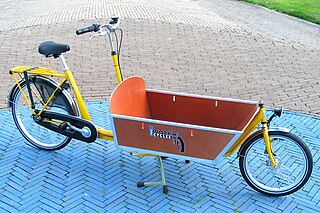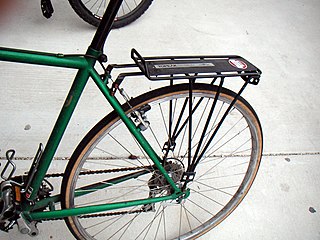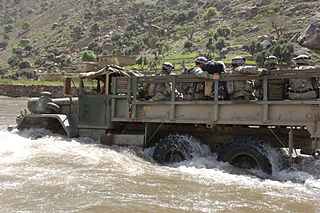Rack or racks may refer to:

A chassis is the load-bearing framework of a manufactured object, which structurally supports the object in its construction and function. An example of a chassis is a vehicle frame, the underpart of a motor vehicle, on which the body is mounted; if the running gear such as wheels and transmission, and sometimes even the driver's seat, are included, then the assembly is described as a rolling chassis.

A forklift is a powered industrial truck used to lift and move materials over short distances. The forklift was developed in the early 20th century by various companies, including Clark, which made transmissions, and Yale & Towne Manufacturing, which made hoists.

There have been many human powered vehicles designed and constructed specifically for transporting loads since their earliest appearance in the 20th century. They are referred to variously depending on the number of wheels — typically two, three, or four — and by their specific use. Adjectives used to describe the tasks to which the bicycles, dicycles, tricycles, or quadracycles are put include cargo cycles, freight cycles, box cycles, carrier cycles, and so on. Sometimes they are also called cycletrucks, which uses a sense of the word 'truck' predating the automobile.

A crane is a machine used to move materials both vertically and horizontally, utilizing a system of a boom, hoist, wire ropes or chains, and sheaves for lifting and relocating heavy objects within the swing of its boom. The device uses one or more simple machines, such as the lever and pulley, to create mechanical advantage to do its work. Cranes are commonly employed in transportation for the loading and unloading of freight, in construction for the movement of materials, and in manufacturing for the assembling of heavy equipment.

A touring bicycle is a bicycle designed or modified to handle bicycle touring. To make the bikes sufficiently robust, comfortable and capable of carrying heavy loads, special features may include a long wheelbase, frame materials that favor flexibility over rigidity, heavy duty wheels, and multiple mounting points.

A trailer is an unpowered vehicle towed by a powered vehicle. It is commonly used for the transport of goods and materials.

A dump truck, known also as a dumping truck, dump trailer, dumper trailer, dump lorry or dumper lorry or a dumper for short, is used for transporting materials for construction as well as coal. A typical dump truck is equipped with an open-box bed, which is hinged at the rear and equipped with hydraulic rams to lift the front, allowing the material in the bed to be deposited ("dumped") on the ground behind the truck at the site of delivery. In the UK, Australia, South Africa and India the term applies to off-road construction plants only and the road vehicle is known as a tip lorry, tipper lorry, tipper truck, tip truck, tip trailer or tipper trailer or simply a tipper.

A tow hitch is a device attached to the chassis of a vehicle for towing, or a towbar to an aircraft nose gear. It can take the form of a tow ball to allow swiveling and articulation of a trailer, or a tow pin, or a tow hook with a trailer loop, often used for large or agricultural vehicles where slack in the pivot pin allows similar movements. Another category is the towing pintle used on military vehicles worldwide.

A gantry crane is a crane built atop a gantry, which is a structure used to straddle an object or workspace. They can range from enormous "full" gantry cranes, capable of lifting some of the heaviest loads in the world, to small shop cranes, used for tasks such as lifting automobile engines out of vehicles. They are also called portal cranes, the "portal" being the empty space straddled by the gantry.

A bicycle trailer is a motorless wheeled frame with a hitch system for transporting cargo by bicycle. It can greatly increase a bike's cargo capacity, allowing point-to-point haulage of objects up to 3 cubic metres in volume that weigh as much as 500 kg. However, very heavily loaded trailers may pose a danger to the cyclist and others, and the voluntary European standard EN 15918 therefore suggests a maximum load of 60 kg on trailers without brakes.

A semi-trailer is a trailer without a front axle. The combination of a semi-trailer and a tractor truck is called a semi-trailer truck.

A roof rack is a set of bars secured to the roof of an automobile. It is used to carry bulky items such as luggage, bicycles, canoes, kayaks, skis, or various carriers and containers.

A flatbed truck is a type of truck the bodywork of which is just an entirely flat, level 'bed' with no sides or roof. This allows for quick and easy loading of goods, and consequently they are used to transport heavy loads that are not delicate or vulnerable to rain, and also for abnormal loads that require more space than is available on a closed body. Flatbed trucks can be either articulated or rigid.

Pallet rack is a material handling storage aid system designed to store materials on pallets. Although there are many varieties of pallet racking, all types allow for the storage of palletized materials in horizontal rows with multiple levels. Forklift trucks are usually required to place the loaded pallets onto the racks for storage. Since the Second World War, pallet racks have become a ubiquitous element of most modern warehouses, manufacturing facilities, retail centers, and other storage and distribution facilities. All types of pallet racking increase storage density of the stored goods. Costs associated with the racking increases with increasing storage density.

A luggage carrier, also commonly called a (bicycle)rack, is a device attached to a bicycle to which cargo or panniers can be attached. This is popular with utility bicycles and touring bicycles.
Motorcycle accessories are features and accessories selected by a motorcycle owner to enhance safety, performance, or comfort, and may include anything from mobile electronics to sidecars and trailers. An accessory may be added at the factory by the original equipment manufacturer or purchased and installed by the owner post-sale as aftermarket goods. The term Farkle is used within the motorcycle community, originally to denote useful add-ons, such as GPS or other upgraded components. Now also used at times in a humorous or mildly derogatory way to describe bling, such as anodized or chromed parts that add no functionality.

The M809 Series 5-ton 6x6 truck (G908) was a family of heavy tactical trucks built for the United States Armed Forces. The basic cargo version was designed to transport a 5-ton (4,500 kg), 14 ft (4.3 m) long load over all terrain in all weather. In on-road service the load weight was doubled. Built by AM General, they evolved into the M939 Series.
















